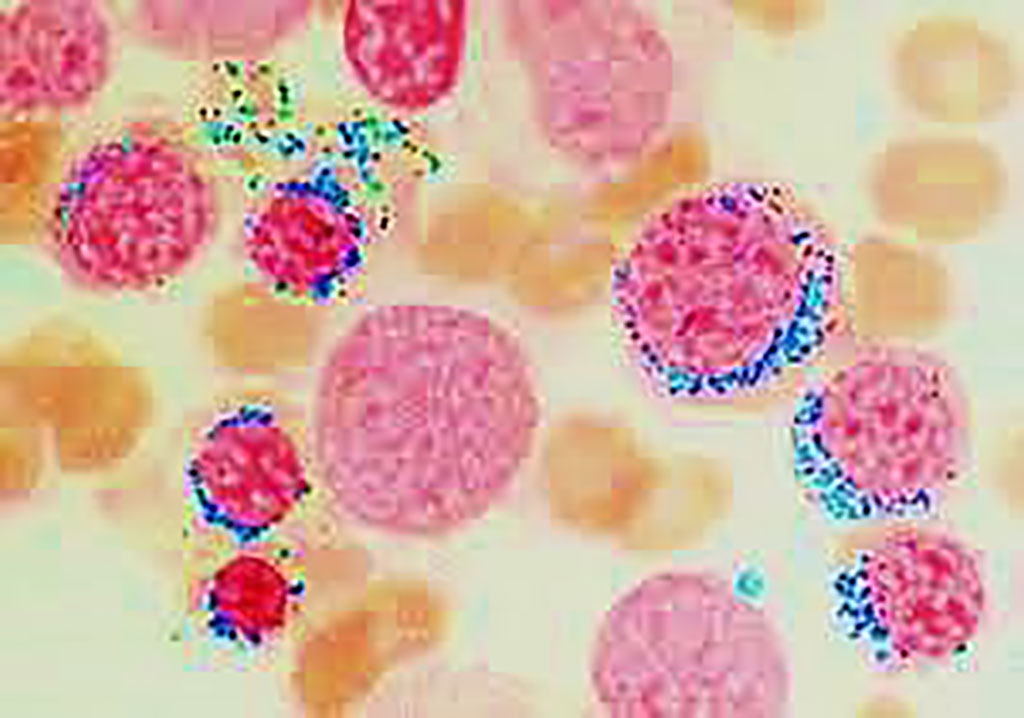Hematological and Molecular Parameters Defined for CCUS and MDS
By LabMedica International staff writers
Posted on 11 May 2021
Patients with clonal cytopenia of undetermined significance (CCUS) have low blood counts and a normal bone marrow examination, but more advanced genetic testing shows the presence of a genetic mutation that is likely causing the low counts. Posted on 11 May 2021
Myelodysplastic syndromes (MDS) are clonal hematopoietic stem cell disorders, conditions that can occur when the blood-forming cells in the bone marrow become abnormal. This leads to low numbers of one or more types of blood cells. MDS is considered a type of cancer.

Image: Bone marrow smear from a patient with refractory anemia (MDS) with ring sideroblasts. Classic appearance of ring sideroblasts shows iron deposition in a `necklace` around the nucleus using Perls stain (Photo courtesy of University of Pavia)
Hematologists at the Mayo Clinic (Rochester, MN, USA) and their colleagues included in a study a total of 187 patients: 75 (40%) with CCUS and 112 (60%) with Lower-risk MDS (LR-MDS), with a median age of 66 years (63% male). In the CCUS group, 59 (78%) patients had ≥1 somatic mutation, eight (11%) had clonal cytogenetic abnormalities only, and eight (11%) patients had both somatic mutations and clonal cytogenetic abnormalities. Sixty-seven (92%) patients had ≥1 somatic mutation, with 45 (61%) having >1 mutation. Common mutations in CCUS included TET2 (30%), SRSF2 (20%), DNMT3A (13%), and ASXL1 (11%) with 17 (23%) patients being red cell transfusion dependence (TD) and 10 (13%) being platelet TD at diagnosis.
The scientists reported that in comparison with patients with CCUS, LR-MDS patients were more likely to have higher white blood cell counts (WBC), higher absolute neutrophil counts (ANC)), higher platelet counts, be red cell TD, have bone marrow (BM) ring sideroblasts (RS), have higher BM blast%, and have SF3B1 mutations, whereas CCUS patients were more likely to have higher absolute monocyte counts (AMC). The team observed higher WBC/ANC and platelet counts in MDS patients in comparison with CCUS patients, largely because of the fact that 50% of the MDS cohort comprised of patients with MDS-RS- single lineage dysplasia (SLD), where the dysplasia is largely limited to the erythroid lineage, sparing granulocyte and megakaryocyte development and maturation.
The authors concluded that their data, among others, have led to operational classification criteria for the diagnosis of CCUS that includes the presence of myeloid-relevant somatic mutations with a variant allele frequency (VAF) ≥20%, without overt bone marrow (BM) dysplasia (<10% dysplastic cells). They strongly urge the academic community to consider including CCUS, especially CCUS-HighVAF (≥20%), as a MDS subtype in the next iteration of the WHO classification system. The study was published on April 27, 2021 in the journal Blood Advances.
Related Links:
Mayo Clinic













